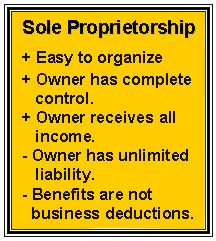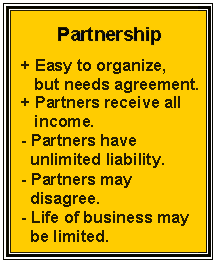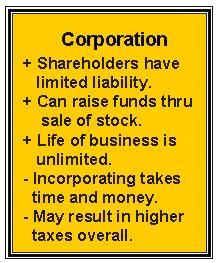Business Entity
Step 6: LEGAL SET-UP: Forms of Business Ownership
One of the first decisions that you will have to make as a business owner is how the company should be structured. This decision will have long-term implications, so you want to make sure to review your options carefully. In making a choice, you will want to take into account the following:
|
|
 |
An excellent tool to help you decide which business structure (ex. Corporation, LLC) is right for you. This worksheet also includes tax calculations. (2 Sheets) | ||||||
SOLE PROPRIETORSHIPS
The vast majority of small business start out as sole proprietorships. These firms are owned by one person, usually the individual who has day-to-day responsibility for running the business. Sole proprietors own all the assets of the business and the profits generated by it. They also assume complete responsibility for any of its liabilities or debts. In the eyes of the law and the public, you are one in the same with the business. |  |
Advantages of a Sole Proprietorship
- Easiest and least expensive form of ownership to organize.
- Sole proprietors are in complete control, and within the parameters of the law, may make decisions as they see fit.
- Sole proprietors receive all income generated by the business to keep or reinvest.
- Profits from the business flow-through directly to the owner's personal tax return.
- The business is easy to dissolve, if desired.
Disadvantages of a Sole Proprietorship
- Sole proprietors have unlimited liability and are legally responsible for all debts against the business. Their business and personal assets are at risk.
- May be at a disadvantage in raising funds and are often limited to using funds from personal savings or consumer loans.
- May have a hard time attracting high-caliber employees, or those that are motivated by the opportunity to own a part of the business.
- Some employee benefits such as owner's medical insurance premiums are not directly deductible from business income (only partially deductible as an adjustment to income).
Federal Tax Forms for Sole Proprietorship
(only a partial list and some may not apply)
- Form 1040: Individual Income Tax Return
- Schedule C: Profit or Loss from Business (or Schedule C-EZ)
- Schedule SE: Self-Employment Tax
- Form 1040-ES: Estimated Tax for Individuals
- Form 4562: Depreciation and Amortization
- Form 8829: Expenses for Business Use of your Home
PARTNERSHIPS
In a Partnership, two or more people share ownership of a single business. Like proprietorships, the law does not distinguish between the business and its owners. The Partners should have a legal agreement that sets forth how decisions will be made, profits will be shared, disputes will be resolved, how future partners will be admitted to the partnership, how partners can be bought out, or what steps will be taken to dissolve the partnership when needed;. Yes, its hard to think about a "break-up" when the business is just getting started, but many partnerships split up at crisis times and unless there is a defined process, there will be even greater problems. They also must decide up front how much time and capital each will contribute, etc. |  |
Advantages of a Partnership
- Partnerships are relatively easy to establish; however time should be invested in developing the partnership agreement.
- With more than one owner, the ability to raise funds may be increased.
- The profits from the business flow directly through to the partners' personal tax returns.
- Prospective employees may be attracted to the business if given the incentive to become a partner.
- The business usually will benefit from partners who have complementary skills.
Disadvantages of a Partnership
- Partners are jointly and individually liable for the actions of the other partners.
- Profits must be shared with others.
- Since decisions are shared, disagreements can occur.
- Some employee benefits are not deductible from business income on tax returns.
- The partnership may have a limited life; it may end upon the withdrawal or death of a partner.
Types of Partnerships that should be considered:
- General Partnership
Partners divide responsibility for management and liability, as well as the shares of profit or loss according to their internal agreement. Equal shares are assumed unless there is a written agreement that states differently. - Limited Partnership and Partnership with limited liability
"Limited" means that most of the partners have limited liability (to the extent of their investment) as well as limited input regarding management decisions, which generally encourages investors for short term projects, or for investing in capital assets. This form of ownership is not often used for operating retail or service businesses. Forming a limited partnership is more complex and formal than that of a general partnership. - Joint Venture
Acts like a general partnership, but is clearly for a limited period of time or a single project. If the partners in a joint venture repeat the activity, they will be recognized as an ongoing partnership and will have to file as such, and distribute accumulated partnership assets upon dissolution of the entity.
Federal Tax Forms for Partnerships
(only a partial list and some may not apply)
- Form 1065: Partnership Return of Income
- Form 1065 K-1: Partner's Share of Income, Credit, Deductions
- Form 4562: Depreciation
- Form 1040: Individual Income Tax Return
- Schedule E: Supplemental Income and Loss
- Schedule SE: Self-Employment Tax
- Form 1040-ES: Estimated Tax for Individuals
CORPORATIONS
A corporation, chartered by the state in which it is headquartered, is considered by law to be a unique entity, separate and apart from those who own it. A corporation can be taxed; it can be sued; it can enter into contractual agreements. The owners of a corporation are its shareholders. The shareholders elect a board of directors to oversee the major policies and decisions. The corporation has a life of its own and does not dissolve when ownership changes. |  |
Advantages of a Corporation
- Shareholders have limited liability for the corporation's debts or judgments against the corporations.
- Generally, shareholders can only be held accountable for their investment in stock of the company. (Note however, that officers can be held personally liable for their actions, such as the failure to withhold and pay employment taxes.)
- Corporations can raise additional funds through the sale of stock.
- A corporation may deduct the cost of benefits it provides to officers and employees.
- Can elect S corporation status if certain requirements are met. This election enables company to be taxed similar to a partnership.
Disadvantages of a Corporation
- The process of incorporation requires more time and money than other forms of organization.
- Corporations are monitored by federal, state and some local agencies, and as a result may have more paperwork to comply with regulations.
- Incorporating may result in higher overall taxes. Dividends paid to shareholders are not deductible form business income, thus this income can be taxed twice.
Federal Tax Forms for Regular or "C" Corporations
(only a partial list and some may not apply)
- Form 1120 or 1120-A: Corporation Income Tax Return
- Form 1120-W Estimated Tax for Corporation
- Form 8109-B Deposit Coupon
- Form 4625 Depreciation
- Other forms as needed for capital gains, sale of assets, alternative minimum tax, etc.
Subchapter S Corporations
A tax election only; this election enables the shareholder to treat the earnings and profits as distributions, and have them pass thru directly to their personal tax return. The catch here is that the shareholder, if working for the company, and if there is a profit, must pay herself wages, and it must meet standards of "reasonable compensation". This can vary by geographical region as well as occupation, but the basic rule is to pay yourself what you would have to pay someone to do your job, as long as there is enough profit. If you do not do this, the IRS can reclassify all of the earnings and profit as wages, and you will be liable for all of the payroll taxes on the total amount.
Federal Tax Forms for Subchapter S Corporations
(only a partial list and some may not apply)
- Form 1120S: Income Tax Return for S Corporation
- 1120S K-1: Shareholder's Share of Income, Credit, Deductions
- Form 4625 Depreciation
- Form 1040: Individual Income Tax Return
- Schedule E: Supplemental Income and Loss
- Schedule SE: Self-Employment Tax
- Form 1040-ES: Estimated Tax for Individuals
- Other forms as needed for capital gains, sale of assets, alternative minimum tax, etc.
LIMITED LIABILITY COMPANY (LLC)
The LLC is a relatively new type of hybrid business structure that is now permissible in most states. It is designed to provide the limited liability features of a corporation and the tax efficiencies and operational flexibility of a partnership. Formation is more complex and formal than that of a general partnership.
The owners are members, and the duration of the LLC is usually determined when the organization papers are filed. The time limit can be continued if desired by a vote of the members at the time of expiration. LLC's must not have more than two of the four characteristics that define corporations: Limited liability to the extent of assets; continuity of life; centralization of management; and free transferability of ownership interests.
Federal Tax Forms for LLC
Taxed as partnership in most cases; corporation forms must be used if there are more than 2 of the 4 corporate characteristics, as described above.
In summary, deciding the form of ownership that best suits your business venture should be given careful consideration.